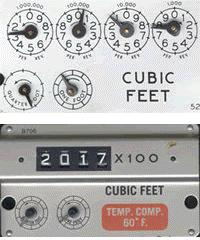 In our continuing series on reading your actually going to combine meters, we are running through the four main types of meters in use today (Water, Gas, Propane, and Electric) along with a few helpful tips for possibly troubleshooting that dreaded “this just can’t be right…”
In our continuing series on reading your actually going to combine meters, we are running through the four main types of meters in use today (Water, Gas, Propane, and Electric) along with a few helpful tips for possibly troubleshooting that dreaded “this just can’t be right…”
2 Types of Natural Gas Meter:
Generally, if you live in the city or a suburb, you probably have natural gas. While I have heard about a few smart meters or even ones with a display on them – I have yet to see one in use. The picture above is courtesy of Trussville Natural Gas, which actually shows the two types of meter displays you may find in their area. Just like the water meter’s we covered in our last article, there are two general ways they measure the usage.
- Cubic Feet (cf) aka an “Imperial Meter” has 4 dials on top — Those four numbers equate to 100cf of usage (aka 1 Ccf or Therm)
- Cubic Meter (cm) aka a “Metric Meter” has 5 dials on top — These five numbers equate to 1 CM or 35.3146cf of usage
No matter which type of meter is used, the numbers are read from the left to the right / from the biggest number to the smallest. You should also note that every other hand actually moves counterclockwise (it is a gearing & reduction issue). If the hand happens to be between two numbers, you would use the lower number; in the case above, you would read it as 2017Ccf or 201700cf.
While there are some additional dials or numbers located on the displays and they equate to how much gas has been used, they are not utilized for billing purposes. As we mentioned in the prior article, there is nothing to say you cannot use them to track your usage patterns though. Generally, most gas utilities will simply state that they are there for testing purposes.
This just can’t be right:
But, but we didn’t have the furnace on, and we cooked on the BBQ all month, and this just doesn’t make sense… While one might get a bill where they misread the meter, the bulk of these types are caused by phantom loads caused by pilot lights, or one not realizing everything that might be running off of gas (i.e. your water heater, gas fireplace, oven, dryer, furnace, pool heater, even some BBQ’s). I will say that if you do have a device that still utilizes a pilot light; it is time to get it replaced, as not only is it very inefficient, but as it gets older, the parts to fix it will be harder to find and it will require maintenance.
While one could say it never happens, it does occasionally, and that is the meter number they have associated with your bill is incorrect. If you think that maybe a possibility or that the meter is broken, you should contact your gas company. In all my years, I have only heard about three wrong meters numbers, but I have seen plenty of cases where some outdated meters had to be replaced due to safety and accuracy factors.
I might have a leak:
In its purest form, natural gas is odorless, so the gas companies add an odorant to help people know that they have a gas leak. If you are just catching a slight whiff of it, you should check to make sure all the oven burners are off, and pilot lights are still lit (please see below). If the smell is overwhelming, go outside & call the gas company immediately from a neighbor’s house – if the number is unavailable then you should call the fire department.
- If a pilot light is out, shut the supply off for at least 5 minutes & let the place air out as you have no way of knowing how much gas has leaked
- If the odor does go away & you feel comfortable with the directions posted on the appliance, relight it
- If the odor does not go away, or you feel uncomfortable, please call your gas company who will generally be glad to come out
A word of caution:
Each year all gas-fired appliances and the venting associated with it, should undergo a yearly inspection and tune up by a licensed and knowledgeable HVAC contractor certified by the NCI or similiar organization. While we feel that all houses should have a carbon monoxide detector in them, it is important that any house with a gas-fired appliance have at least one operable one in them.
Additional Info & Websites:
- HTRC: Monitoring your usage with Smart Meters & MyUsage
- HTRC: Free spreadsheet to help you monitor your utility usage & gas mileage
- HTRC: Reading your Water, Electric, Gas, Propane Meters

Hi,
This is really awesome and very useful post! I just came across to reading your blog it serve very useful information Nice blog, I really glad to used it.
Hi,
This is really awesome and very useful post! I just came across to reading your blog it serve very useful information Nice blog, I really glad to used it.